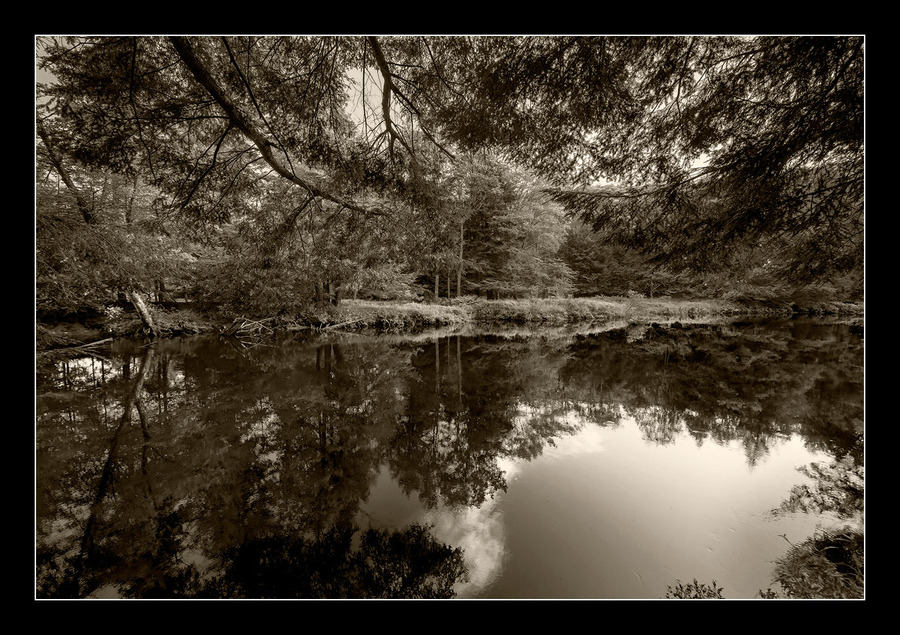We spent a rainy autumn weekend in Canaan Valley. Dolly Sods was a zoo, but when we came down off the mountain and passed through Laneville, things settled down a bit. The rain and fog gave the world a vibrant sheen that calmed my senses after the crowds we endured at Bear Rocks. It was windy and the light rain was hitting hard against my face as I took this shot. I could hardly keep the lens free from water droplets.
Mount Rogers’ Magical Mist

At 5,728 feet, Mount Rogers is the highest point in Virginia. I was told that despite its altitude, (high for an eastern peak) it was a pretty boring destination because there is no view from the top. The last half mile up to the peak is steep with moss covered rocks and ferns covering the forest floor beneath a dense stand of spruce fir. There was no wind in the paradoxical shelter of the mountaintop. It was silent. The humid air fogged my glasses. I sat down and gathered up the pictures I would use for this photo. Some luminance adjustments helped me to tone down the colors to match the feeling of the quiet moments I spent there.
The date of this hike was in August of 2014.
West Virginia Highlands Hygge

The Danish have a word that celebrates dark, winter coziness. It is Hygge, pronounced pronounced “hYOOguh.” I think of it often when people complain of the cold and the dark of winter. In winter, enjoying the outdoors and then coming home and enjoying friends, family and food by a blazing warm fire is how I celebrate winter’s sleepy darkness. This photo captures that idea of coziness under the mountains with a snowy blanket.
source: NPR
Lewis Lodge Anasazi Ruins
In the fall of 2014, I was fortunate enough to have a little extra time on my hands, so I got in the car and drove west.
We bounced down the rutted, boulder-strewn road—in some places so narrow that desert scrub scraped the side of the van—until we the spotted the unmarked trailhead. On foot, our route-finding was a casual mix of GPS checks, topo maps, and old-fashioned tracking—we looked for enduring desert footprints and we followed “trails” where the darkened
cryptobiotic soil was worn away by foot-travel.
We approached Lewis Lodge from the mesa above and descended a narrow slickrock ramp to a ledge crowded with boulders, cactus, and cedar. At the top of the canyon was a running spring and an improbable oasis of grasses and cottonwood. We continued down the other side of the canyon to the crumbling wall defending the thousand-year old Lewis Lodge cliff dwellings.




Beyond the stone gateway the shelf widened and the remains of early Indian structures began. The Kiva structure was miraculously preserved. This meeting house could hold ten or fifteen people. The original wood framing was intact, holding up the stone roof. Precolonial corncobs and pottery shards were laying out on a stone in the middle of the room.



Further down the ledge there were other structures in various states of ruin as the canyon fell away several hundred feet below. I could imagine original Indian inhabitants sitting by a fire on the wide open ledges watching the embers float into the desert sky.

The ledges widened and then narrowed until eventually the paths around the structures were too narrow for my nerves. In the photo below, my friend looks small standing on the cliff-ledge. In these places the power of the place and scale of rock walls always made you feel small.
Autumn Storm Over The Grand Tetons
In the fall of 2014, I was fortunate enough to have a little extra time on my hands, so I got in the car and drove west.
My big road-trip lasted a month and my plans included destinations like The Badlands, Yellowstone, Yosemite, Crater Lake, and Moab. After spending five days poking around Yellowstone National Park, I decided it was time to head south, and directly in my path lay the Grand Tetons.
On this day I awoke to rain in the valleys and snow on the mountaintops. The Yellowstone buffalo wore their snowy blankets, and the grizzly bear was squinting at the big, blowing flakes. At Grand Tetons National Park, there was sun over Jackson lake while the snow storms still clung to the mountain peaks.
This shot was made with two rows of thirteen images using an Olympus EM-1 and a Zuiko 50-200 SWD Four Thirds lens lens at 152mm.

Mono Lake from Highway 395
In the fall of 2014, I was fortunate enough to have a little extra time on my hands, so I got in the car and drove west.
I really should have had Mono Lake on my plan, but that didn’t stop me from stumbling on this photographer’s Mecca when the light was good. I came to this vista from Nevada to the north at a pull-off from highway 395. I recall thinking that I needed to get closer to really capture the lake’s feeling. I was wrong. All the up-close photos I took of Mono Lake were pretty inferior compared to this gem. As is so often the case for my favorite shots, the panoramic series was taken somewhat carelessly as I rushed on to catch the evening light before the lake disappeared behind the mountain shadows.
This shot was made with two rows of twelve images each using an Olympus EM-1 and a Zuiko 50-200 SWD Four Thirds lens lens at 50mm. Processing included balancing levels across the highlights and shadows and a luminosity mask. This combination allowed me to tame the wild contrast of a desert afternoon and to mute the colors of the landscape to match the moment’s truth. If you look around at pictures of Mono Lake you will find lots of highly saturated shots of emerald waters and white sands. Undoubtedly it looks like that on some days, but on this day, in this moment, this is what I found.

Dark Upper Blackwater

Here is another old photo that sat in my queue for a long time. This one since October of 2013. Although I haven’t been blogging on Trailpixie.net, I have been doing a lot of photography. Stay tuned for stories and photos from my month-long cross country trip in the fall of 2014 as well as a huge backlog of photos from the highlands of West Virginia.
The photo above is from the old swinging bridge site along the Blackwater River above Davis, WV. The spot is hidden deeply under dark hemlock shade. It feels like an antique place, so the sepia tone set the perfect mood.
Photo Walk at White Grass

I find that the photos you make and love most are a reflection of your state of mind. Some refer to this as the landscape as inscape. I haven’t written to Trailpixie.net in over a year. I guess I lost my blogging voice….a bit of a cyber-identity crisis.
This photo was taken in the winter of 2014. It sat in the queue waiting for me to write something and post it.
Olson Tower Color

Olson Tower is my favorite cheap thrill of the highlands. Drive up to the bottom of the tower and climb a hundred and fifty feet (I’m guessing) up the stairs to reveal a breath-taking 360 degree view. I am not sure if the drama of the scene is a result of the wind swaying the rusty old metal structure or the view between the gaps in the expanded metal floor of the stair landings. I know this: someday soon, this dangerous old beauty will be shut down and fools like me won’t be able to spend Sunday mornings chasing the wind.

Consider a camera’s field of view, both vertically and horizontally. In this second photo, I have a white-knuckle grip on the railing, and I am holding the camera to my eye. The field of view runs from my belt all the way upward beyond the horizon and into the sky above. To capture this bizarrely wide angle, I vertically stitched three images (with different exposures) from a fisheye lens. Crazy, isn’t it? It sure is, particularly if you paid any attention to how much I had to bend and twist and manipulate the pixels to make them look somewhat “normal.” Amazingly, the image does look somewhat normal, despite the heroic PhotoShop processing that was required. Funny how that can work sometimes.
Fall at Phare’s Hollow Rocks

I love this spot because you can’t see anything man-made in any direction. Across the Red Creek Valley, if you look closely, you can see Lion’s Head commanding the intersection of Big Stonecoal Run and the Red Creek. This distorted view covers over 180 degree view looking south towards Laneville and north towards Blackbird Knob. You can find this beautiful little spot with its grassy campsite by walking a gentle hour from the FR75 Wilderness trail parking lot and turning left on the Rohrbaugh Plains trail.


